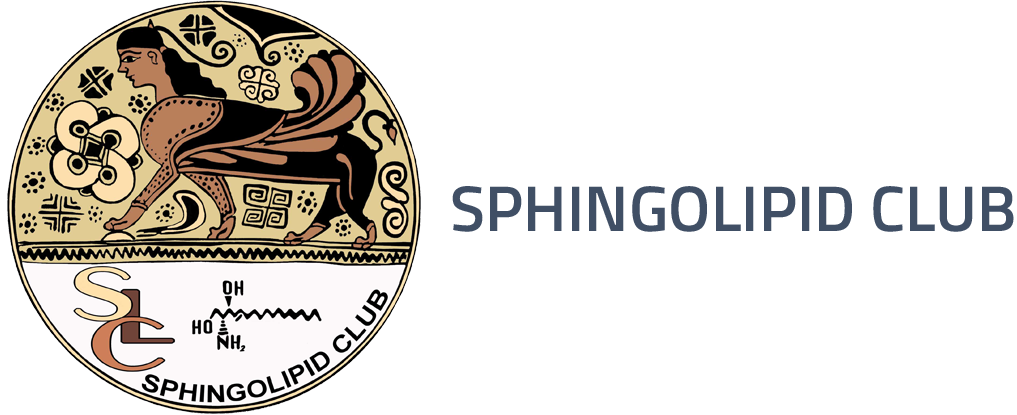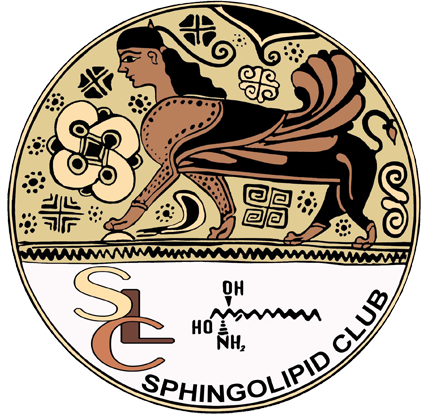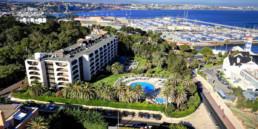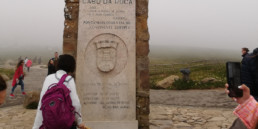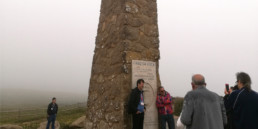13th Meeting
Cascais, Portugal, May 6-10 2019
The 2019 FEBS Special Meeting in Sphingolipid Biology, joint with the Sphingolipid Club and the International Ceramide Conference, has covered interdisciplinary topics associated with Sphingolipid Biology, ranging from emerging tools to study sphingolipid structure and function, to their roles in membrane organization, dynamics, signalling and metabolism. Emphasis has been placed in the role of sphingolipids in several human diseases, including, cancer, metabolic syndrome, genetic disorders and neurodegenerative diseases, both as players in the aetiology and as targets and/or therapeutic entities of those diseases.
Scientific sessions and round-table discussions moderated by recognized leaders of the field, together with poster and oral communications from established, early-stage career scientists and students, has provided the ideal setting for networking and close interaction between speakers and participants.
EMBO Keynote Lecture
“Novel tools and aspects of sphingolipid metabolism and function”
Howard Riezman, University of Geneva
Chair: Myles Cabot, East Carolina University
Session 1 > Innovative Tools to study Sphingolipid Structure and Function
Overview of the Field by the Chair:
Hot Topics and Open Questions
Thorsten Hornemann, University Hospital Zurich
Ceramidases: Chemical Sensors and Inhibitor
Gemma Fabrias, Institute for Advanced Chemistry of Catalonia
Novel applications of Förster resonance energy transfer (FRET) in sphingolipid enzymology
Christoph Arenz, Humboldt Universitat zu Berlin
Short and facile synthesis of a combinatorial library of the CERT inhibitor HPA12
Essa M. Saied, Humboldt Universitat zu Berlin
In-situ single cell lipidomics by imaging mass spectrometry
Laura Capolupo, Ecole Polytechnique federale de Lausanne
The structure and function of alkaline ceramidase 3 are related to adiponectin receptors
Sebastien Granier, Institut de Genomique Fonctionnelle
Temporal and tissue specific requirements of CerS Schlank and the consequences of its inactivation with respect to the complete protein and the two distinct functional domains of the protein
Reinhard Bauer, University of Bonn
Tango for promiscuity: Role of SPTLC3 in generating sphingolipid heterogeneity
Museer Lone
University Hospital Zurich
General Discussion of Session 1
Thorsten Hornemann
Introduction to FEBS activities
Zrinka Kovarik
Session 2: Sphingolipids in Membrane Structure and Dynamics
Overview of the Field by the Chair: Hot Topics and Open Questions
Alicia Alonso
Instituto Biofisika
Sphingolipids: from lipid domain pattern to functioning in Alzheimer’s disease
Galya Staneva
Bulgarian Academy of Sciences
Profound changes in the dynamic properties of the cell membrane due to sphingolipid accumulation in a cellular model of Gaucher’s disease
Peter Nagy
University of Debrecen
The effect of canonical and 1-deoxy(methyl) sphingoid bases in membrane fluidity and lateral organization
Tania Santos
Universidade de Lisboa
GLTP’s emerging role within the lipid synthesis and transport machinery
Anders Backman
Abo Akademi University
Sphingolipid-enriched Domains in Yeast Plasma Membrane: a Biophysical Perspective
Rodrigo F.M. de Almeida
Universidade de Lisboa
Impact of glycosphingolipids on membrane organization: focus on lipid nanodomains and their influence on peptide-membrane interactions
Maria J. Sarmento
J. Heyrovský Institute of Physical Chemistry
Sphingolipid headgroup impact on gel domains in Saccharomyces cerevisiae plasma membrane
Joaquim Trigo Marques
Universidade de Lisboa
How to get sphingolipids to the plasma membrane a lipid sorting story
Joanna Podkalicka
Institut Curie
General Discussion of Session 2
Alicia Alonso
Session 3: Sphingolipids in Cell Physiology: Signaling, Trafficking, and Metabolism Part 1
Overview of the Field by the Chair: Hot Topics and Open Questions
Sarah Spiegel
Virginia Commonwealth University
Yasuyuki Igarashi
Hokkaido University
Membrane lipids and the activity of sphingolipid-cleaving hydrolases
Konrad Sandhoff
University of Bonn
0 Molecular dissection of ceramide-induced apoptosis using photo-actuated lipid probes
Joost Holthius
University of Osnabruck
The role of acid sphingomyelinase activity in the regulation of CREB Signaling
Cosima Rhein
FAU Erlangen-Nurnberg
The Unfolded Protein Response (UPR) activator ATF6 responds to proteotoxic and lipotoxic stress by distinct mechanisms
Maho Niwa-Rosen
University of California San Diego
Sphingolipid de novo biosynthesis: Regulation and pathological impact
Anna Rita Di Lorenzo
Weill Cornell Medical College
Sphingolipids and Flaviviruses: an intimate union
Fikadu Tafesse
Oregon Health and Science University
The glycosphingolipid metabolic switch controls neural differentiation
Domenico Russo
Institute of Protein Biochemistry – Consiglio Nazionale delle Ricerche
Ceramide nanoliposomes and autophagic inhibitors synergize in resistant Head and Neck Squamous Cell Carcinoma
Jeremy Shaw
University of Virginia
Session 3: Sphingolipids in Cell Physiology: Signaling, Trafficking, and Metabolism Part 2
Systematic development of natural ligand-nonmimetic inhibitors to the ceramide transport protein CERT
Kentaro Hanada
National Institute of Infectious Diseases
Sphingolipid synthesis inhibition by Myriocin post conditioning enhances lipid consume and ameliorates response to myocardial I/R injury
Paola Signorelli
University of Milan
The juxtamembrane linker functions as an intramolecular allosteric switch to activate neutral sphingomyelinase-2
Prajna Shanbhogue
Stony Brook University
The neutral sphingomyelinase 2 is required for endoplasmic reticulum-plasma membrane communication and cholesterol turnover in T cell Activation
Elita Avota
University Wuerzburg
Ceramide regulates interaction of Hsd17b4 with Pex5 and function of peroxisomes.
Erhard Bieberich
University of Kentucky
Differential roles of ceramide synthases in pancreatic beta cell demise
Kerstin Grieß
German Diabetes Center DDZ
Lipid patterning and interplay during protein sorting at transGolgi network
Yohann Boutte
CNRS
Sphingosine kinase 1: An enigmatic regulator of the adipocyte circadian transcription complex
Andrea Anderson
Virginia Commonwealth University
S1P1 receptor activity in rodent brain
Jonatan Martinez-Gardeazabal
University of the Basque Country
General Discussion of Session 3
Sarah Spiegel, Yasuyuki Igarashi
Session 4: Sphingolipids in Health and Disease Part 1
Overview of the Field by the Chair: Hot Topics and Open Questions
Thierry Levade, Paul Sabatier
University of Toulouse
Antonio Gomez-Munoz
University of the Basque Country
Membrane sphingolipid synthesis and metabolic regulation: a novel function of GPRC5B
Yoshio Hirabayashi
RIKEN
Ceramide acyl chain length affects hepatic triglycerides via regulating endoplasmic reticulum stress
Joo-Won Park
Ewha Womans University
Dissecting the role of sphingolipids in the phagocytic clearance of pathogens
Patrick Niekamp
University of Osnabrueck
Targeting dihydroceramide desaturase (DEGS1) to overcome anoikis resistance in HER2-positive breast cancer
Christopher J. Clarke
Stony Brook University
Homeostatic and pathogenic roles of GM3 ganglioside molecular species in TLR4 signaling
Jin-Ichi Inokuchi
Tohoku Medical and Pharmaceutical University
Cancer Associated Glycosphingolipids as Targets for Immunotherapy
Alice Yu
Chang Gung University
Protumorigenic activity of Betagalactosylceramidase: A novel player in cutaneous melanoma
Mirella Belleri
University of Brescia
SMPDL3B is a Major Regulator of Proteinuria in Experimental Alport Syndrome
Alla Mitrofanova
University of Miami
Session 4: Sphingolipids in Health and Disease Part 2
Ceramide metabolism alterations in melanoma: from basic mechanisms to immunotherapy in advanced melanoma patients
Bruno Segui
Cancer Research Center of Toulose
Regulation of Sphingomyelin Synthase 1 in Leukemia: an Interesting “Start”
Chiara Luberto
Stony Brook University
Sphingolipid modulation activates autophagy and proteostasis programs to govern human hematopoietic stem cell self-renewal
Stephanie Xie
Princess Margaret Cancer Centre
Sphingosine kinases are key effectors of IL7R-mediated signaling, viability, growth and proliferation in T-cell Acute Lymphoblastic Leukemia
Marta B. Fernandes
Universidade de Lisboa
Targeting sphingosine kinases in disease
Susan Pyne
University of Strathclyde
The Apolipoprotein M/S1P axis controls triglyceride metabolism and brown fat activity
Christina Christofferson
Rigshospitalet
Non-canonical sphingolipids mediate cardiomyocyte death in models of ischemia
Anna Kovilakath
Virginia Commonwealth University
Glycosphingolipid Dynamics in Human Embryonic Stem Cell and Cancer
John Yu
Chang Gung University
The Good, the Bad and the Ugly: 1-deoxysphingolipids in anoxic death, viral infections and anthrax intoxication
J. Thomas Hannich
University of Geneva
General Discussion of Session 4
Thierry Levade, Antonio Gomez-Munoz
Session 5: ISN Symposium on Sphingolipids in Neural Pathologies
Overview of the Field by the Chair: Hot Topics and Open Questions
Elisabetta Albi
University of Perugia
The role of host Glycosphingolipids in viral infection of the CNS
Einat Vitner
Israel Institute of Biological Research
The role of the non-lysosomal glucosylceramidase GBA2 in regulation locomotion
Dagmar Wachten
University of Bonn
Chronic stress causes neurodegeneration through AMPA receptor and Gd1a ganglioside in age and sex specific manner in rats
Marta Balog
University of Osijek
Regulation of major depression by lysosomal sphingolipids
Erich Gulbins
University Hospital Essen
Sphingolipid metabolism: new perspectives for treating Huntington’s disease
Vittorio Maglione
Neuromed
General Discussion of Session 5
Elisabetta Albi
Keynote Lecture
“ER-Golgi Contact Sites”
Maria De Matteis
TIGEM
Chair: Tony Futerman
Weizmann Institute
Concluding Remarks
Liana Silva & Giovanni D’Angelo
POSTER SESSION 1
1. “The lipid status in patients with ulcerative colitis: inhibition of the sphingolipid de novo synthesis might be an important trigger for UC”
Sabine Groesch
Goethe-University
2. “A new mouse model exploring chronic neuronopathic Gaucher Disease”
Yael Pewzner-Jung
Weizmann Institute of Science
3. “Role of sphingolipids and their metabolites in mycobacteria engulfment and escape of pathogenic mycobacteria from human phagocytes”
Kazuhisa Iwabuchi
Junteno University
4. “In vivo validation of two novel S1P1-selective compounds, ST-1893 and ST-1894, in the experimental autoimmune encephalomyelitis model in mice”
Bisera Stepanovska
University of Bern
5. “Characterization of ARC39, a new inhibitor of acid sphingomyelinase”
Eyad Naser
University Hospital Essen
6. “Alleviation of Alzheimer’s disease pathology by ceramide-modulated extracellular vesicles”
Yasuyuki Igarashi
Hokkaido University
7. “Gaucher disease neuronal cell models under biophysical investigation: changes in membrane fluidity”
Sarka Pokorna
Weizmann Institute of Science
8. “CerS6 and GCS regulate not only multiple drug resistance, but also estrogen receptor expression”
WooJae Park
Lee Gil Ya Cancer and Diabetes Institute
9. “Downregulation of the S1P transporter spinster homology protein 2 (Spns2) exerts an antifibrotic and antiinflammatory effect in human renal proximal tubular epithelial cells”
Andrea Huwiler
University of Bern
10. “The glucosylceramide synthase inhibitor PDMP inhibits lysosomal sphingolipid degradation”
Pia Hartwig
Heidelberg University
11. “Lead Optimization of Sphingosine Kinase 1 Inhibitor”
Bernandie Jean
Stony Brook University
12. “Tackling a possible relationship between fungal plasma membrane biophysical properties and antifungal sensitivity”
Filipa C. Santos
Universidade de Lisboa
13. “Dynamics of glucosylceramide metabolism in the endocytic pathway”
Lya Holland
Danish Cancer Society
14. “Development of inhibitors of neutral ceramidase with cytotoxic activity on colon cancer cells “
Nuria Bielsa
Institute for Advanced Chemistry of Catalonia
15. “LAPTM4B is sorted in multivesicular endosomes and regulates the exosomal sphingolipid content”
Tomas Blom
University of Helsinki
16. “Modulation of lipid metabolism in human neuroblastoma cells infected with tick borne encephalitis virus “
Pavlina Simeckoba
Veterinary Research Institute
17. “A transcriptomic approach to identify the sphingolipid metabolic pathway in gut-associated Bacteroides”
Stacey Heaver
Max Planck Institute for Developmental Biology
18. “Searching for candidates for novel lipidomic biomarkers in colon cancer-derived tissue samples”
Miroslav Machala
Veterinary Research Institute
19. “Molecular mechanisms regulating Nogo-B interaction with SPT in health and disease states”
Linda Sasset
Weill-Cornell Medical College
20. “Myriocin potential as a phenotype-modifying therapeutical in Cystic Fibrosis”
Alessadra Mingione
University of Milan
21. “Sphingosine kinase 1 as a therapeutic target in mutant or null p53 thymic lymphoma.”
Fabiola Velazquez
Stony Brook University
22. “The linoleic acid content of the stratum corneum of ichthyotic Golden retriever dogs is reduced as compared to healthy dogs and a significant part is oxidized in both free and esterified forms”
Iuliana Popa
Paris-Sud University
23. “Inflammatory role of extracellular lipids in Cystic Fibrosis”
Anna Caretti
University of Milan
24. “Roles of ceramide in necroptosis regulation”
Kazayuki Kitatani
Setsunan University
25. “Modulation of ceramide levels in rabbit’s eyes by eye-drop myriocin administration”
Michele Dei Cas
University of Milan
26. “Therapeutic Efficacy of Ceramide NanoLiposomes in Androgen-Receptor Negative Prostate Cancer“
Pedro Costa-Pinheiro
University of Virginia
27. “Endogenous ceramide species generated from C2-ceramide inhibit insulin signal in muscle cells”
Eric Hajduch
Centre De Recherche Des Cordeliers
28. “Sphingolipid levels in ischemic stroke – effects on stroke size and post-stroke immunosuppression”
Robert Brunkhorst
University Clinic Frankfurt Am Main
29. “Aberrant DEGS1 activity alters sphingolipid metabolism and causes leukodystrophy and axonal degeneration”
Thorsten Hornemann
Zurich University
30. “Blood ceramides as markers for renal impairment in SLE”
Alexander Koch
University Hospital and Goethe University
31. Pre-clinical models for testing L-serine supplementation for preventing taxane-induced neuropathy”
Stefanka Spassieva
University of Kentucky
32. “General polarization and AFM study of sphingolipid-deficient cell membranes”
Bingen G. Monasterio
Instituto Biofisika
33. “Selective disruption of sphingosine kinase 1 in pancreatic β cell impairs insulin secretion but increases β cell mass during obesity”
Herve Le Stunff
Universite Paris-Sud
34. “Alterations in membrane biophysical properties caused by cell culture conditions“
Ana Ester Ventura
iMed-Universidade de Lisboa
35. “Plasma sphingolipids and risks of atrial fibrillation sudden cardiac death in older adults: the Cardiovascular Health Study”
Rozenn Lemaitre
University of Washington
36. “Investigation of lysosomal dysfunction and potential novel therapeutic targets in lysosomal storage diseases”
Kamilla Meyer
Orphazyme
37. “Protective effects of S1P signaling and metabolism on experimental sepsis”
Anke Ziegler
University Hospital Jena
38. “Sphingolipid inventory and variability in human platelets and plasma”
Jeongah Oh
National University of Singapore
39. “Are Nanodomains Enriched with Sphingomyelin Inter-Leaflet Coupled?”
Radek Sachl
J. Hevrosky Institute of Physical Chemistry
40. “Mechanisms of sphingolipid processing revealed by a SapA-GALC complex”
Janet Deane
University of Cambridge
41. “Targeting sphingolipid metabolism as a novel Osteosarcoma treatment”
Sofia Avnet
Rizzoli Orthopaedic Institute
42. “RVT-801, an investigational enzyme replacement therapy for Farber disease, reduces ceramide levels and ameliorates the pro-inflammatory phenotype in a Farber mouse model”
Alexander Solyom
Enzyvant
43. “The UDP-glucose ceramide glucosyltransferase (UGCG) impacts breast cancer cell energy metabolism”
Nina Schoemel
University Clinic Frankfurt Am Main
44. “Regulation of the sphingolipid pattern in Andean Children born and living at high altitude”
Pietro Barbacini
University of Milan
45. “Mass spectrometric tracking of the sphingolipid de novo pathway via isotope labeled substrates in rat microsomes”
Dominik Wigger
Universitat Potsdam
46. “Probing sphingolipid flux in response to chemotherapeutics.”
Justin Snider
Stony Brook University
47. “Niemann-Pick Type C disease: At the Crossroads of Cholesterol and Sphingolipid Metabolism”
Jason Newton
Virginia Commonwealth University
POSTER SESSION 2
1. “Acylceramide production and skin barrier formation by the fatty acid ω-hydroxylase CYP4F22/Cyp4f39”
Akio Kihara
Hokkaido University
2. “Biophysical impact of lipid abnormal accumulation in NPC 1 cell models”
Liana Silva
Universidade de Lisboa
3. “The impact of the UDP-glucose ceramide glucosyltransferase (UGCG) on the energy metabolism of breast cancer cells”
Marthe-Susanna Wegner
University Clinic Frankfurt Am Main
4. “How to detect the unknown knowns: low abundant intermediates of plant sphingolipid metabolism”
Cornelia Herrfurth
Georg-August-University Goettingen
5. “Role of acid sphingomyelinase in mycobacterial infection”
Yuqing Wu
University Hospital Essen
6. “Sphingomyelin in intranuclear environment”
Elisabetta Albi
University of Perugia
7. “Saturated fatty acid-induced inflammation: roles for sphingolipid metabolism”
Songhwa Choi
Stony Brook University
8. “Could changes in sphingolipid metabolism/transcriptome reflect neurotoxicity of environmental pollutants?”
Jirina Prochazkova
Veterinary Research Institute
9. “Multipolar approach to decipher Glycosyl Inositol Phosphoryl Ceramides’ (GIPCs) properties in plasma membrane nanodomain formation using biophysical tools”
Adillah Mamode Cassim
CNRS-Bordeaux University
10. “Post translational regulation of Glycosphingolipid Synthesizing Enzymes (GSE’s) in neurogenesis.”
Jaipreet Loomba
Ecole Polytechnique Federale de Lausanne
11. “Interactions between Ceramides and Lysophospholipids in Fluid Phosphatidylcholine Bilayers”
Md Abdullah Sazzad
Abo Akademi University
12. “Design and Synthesis of Different FRET Probes for The Functional Analysis of The Acid Sphingomyelinase”
Zainelabdeen Ahmed
Humboldt Universitat zu Berlin
13. “GOLPH3 promotes oncogenesis by controlling the intra-Golgi trafficking of glycosphingolipid synthases”
Riccardo Rizzo
Institute of Protein Biochemistry
14. “The protective effect of inhibiting sphingosine kinase 2 in a psoriasis-like mouse model”
Younghay Lee
Ewha Womans University
15. “Probing the interaction of GOLPH3 with glycosphingolipid synthesizing enzymes”
Anthony Vocat
Swiss Federal Institute of Technology
16. “New fluorogenic probes for neutral and alkaline ceramidases”
Mireia Casasampe
Institute for Advanced Chemistry of Catalonia
17. “Sphingolipids are privileged players in polyphenol-membrane interactions”
Carla Sousa
Universidade de Lisboa
18. “Induction of isometamidium resistance in Trypanosoma brucei is associated with alterations in the parasites’ sphingolipid complement”
Emily Dickie
University of Glasgow
19. “LXR protects from Fumonisin B1 toxicity”
Nicolas Loiseau
INRA-Toxalim
20. “Activity-Based Imaging of Acid Ceramidase in Living Cells”
Mazen Aseeri
Institute for Advanced Chemistry of Catalonia
21. “Role of Sphingosine kinase 1 and 2 in skeletal muscle cells”
Federica Pierucci
University of Florence
22. “Targeting SK1 to enhance oncogene-induced senescence”
Magali Trayssac
Stony Brook University
23. “Gaining optical control over sphingolipid metabolism and signaling with photoswitchable lipid probes“
Tolulope Sokoya
University of Osnabruck
24. “Pro-inflammatory role of Spns2/S1P in microglia”
Guanghu Wang
University of Kentucky
25. “The role of ceramide synthases in human colorectal cancer progression”
Sebastien Brachtendorf
University Clinic Frankfurt Am Main
26. “An HPLC method using NBD C6-Ceramide to measure flux of sphingolipids in the Golgi”
Allen H. Lee
Stony Brook University
27. “Role of a novel C-terminal motif in the regulation of ceramide synthases”
Jiyoon Kim
Weizmann Institute of Science
28. “Implication of ceramide 1-phosphate in pre-adipocyte proliferation. Possible role in obesity.”
Asier Dominguez-Herrera
University of the Basque Country
29. “Clostridium perfringens phospholipase C, the main virulence factor in gas gangrene, causes Cer production on ganglioside deficient cells”
Laura Monturiol
Universidade de Costa Rica
30. “Pazopanib Radio-sensitization of Human Sarcoma Tumors via aSMase Activation”
Adriana Haimovitz-Friedman
Memorial Sloan Kettering Institute
31. “Implication of sphingolipid metabolites in non-alcoholic fatty liver disease in phosphatidylethanolamine N-methyltransferase deficient mice. Role of vitamin E”
Natalia Presa
University of the Basque Country
32. “Race disparity in blood sphingolipidomics associated with accelerated lupus vascular comorbidity”
Samar Hammad
Medical University of South Carolina
33. “Atypical and canonical sphingoid bases affect the permeability of model membranes”
Beatriz Mestre
Universidade de Lisboa
34. “Sphingosine 1-phosphate receptors in renal diseases”
Timon Eckes
University Hospital and Goethe University Frankfurt
35. “Role of NSM-2 in early TCR metabolic signaling”
Maria de Lira
University Wuerzberg
36. “A study of the fatty acid compositions of ceramides and sphingomyelins in mammalian tissues and cultured cells”
Alicia Alonso
Instituto Biofisika
37. “1-deoxy-dihydroceramides inhibit the migration of NIH-3T3 cells”
Gergely Karsai
University Hospital Zurich
38. “Sphingolipid biosynthesis and function in bacteria”
Jonathan Padilla-Gomez
Center for Genome Sciences
39. “A Role for 1-O-acylceramide synthase (lysosomal phospholipase A2) in Drug Induced Phospholipidosis”
Vania Hinkovska-Galcheva
University of Michigan
40. “Hepatocyte-Expressed Sphingosine-Kinase-1 is Implicated in a Female-Specific Repression of Fibrosis”
David Montefusco
Virginia Commonwealth University
41. “Experimental autoimmune encephalomyelitis (EAE) was ameliorated by phytoceramide in mice”
Seikwan Oh
Ewha Womans University
42. “Influence of serum albumin (SA) and high-density lipoproteins (HDL) on the signal transduction of sphingosine 1- phosphate (S1P) and its receptors”
Susann Hofmann
Jena University Hospital
43. “Unfolding the mechanism of NLP interactions with plant lipid membranes”
Katja Pirc
National Institute of Chemistry
44. “Sphingolipids required for survival of Caulobacter crescentus”
Roberto J. Olea-Ozuna
Center for Genome Sciences
45. “Ormdls are crucial for normal myelination”
Richard Proia
NIDDK, National Institutes of Health
46. “Host defense mechanisms against pathogens mediated by sphingolipids”
Tina Muller
University Hospital Jena
47. “CSF sphingolipids for the diagnosis of iNPH and AD pathologies”
Enrica Torretta
University of Milan
48. “The role of sialidase NEU3 in the cardiac response to Ischemia and Reperfusion injury”
Maria E. Canali
IRCCS Policlinico San Donato
49. “Synthesis and application of multifunctional sphingolipid derivatives”
Emma Farley
Oregon Health and Science University
